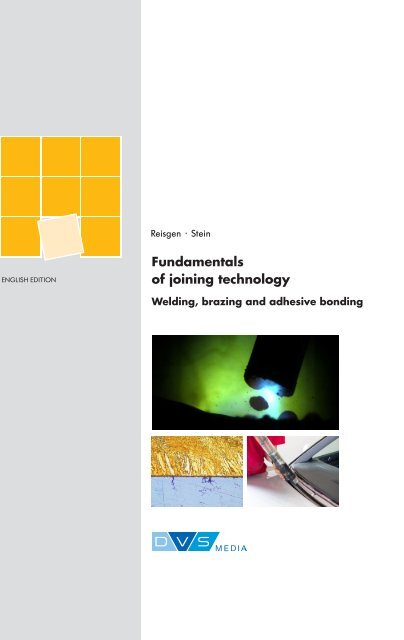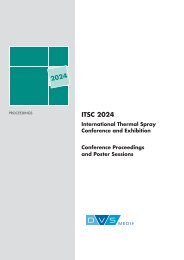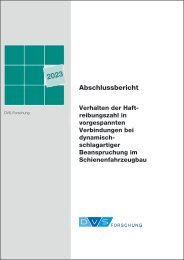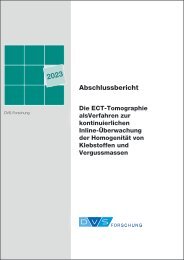180015_Leseprobe
You also want an ePaper? Increase the reach of your titles
YUMPU automatically turns print PDFs into web optimized ePapers that Google loves.
Reisgen · Stein<br />
ENGLISH EDITION<br />
Fundamentals<br />
of joining technology<br />
Welding, brazing and adhesive bonding
Reisgen ∙ Stein<br />
Fundamentals of<br />
joining technology<br />
Welding, brazing<br />
and adhesive bonding
Bibliographic information published by the Deutsche Nationalbibliothek<br />
The Deutsche Nationalbibliothek lists this publication in the Deutsche<br />
Nationalbibliografie; detailed bibliographic data are available in the Internet<br />
at htttp://dnb.dnb.de.<br />
English Edition<br />
Volume 13<br />
ISBN 978-3-945023-76-1<br />
All rights reserved.<br />
© DVS Media GmbH, Düsseldorf · 2016<br />
Printed by: Kraft Druck GmbH, Ettlingen
Preface<br />
In almost every industrial or skilled manual production process, the joining of individual<br />
parts constitutes the decisive step for the manufacturing of subassemblies,<br />
assemblies and finished products. In addition to non-positive-locking and<br />
positive-locking joining processes, material-locking joining processes such as<br />
welding, adhesive bonding or brazing are frequently applied here because of<br />
their specific advantages in both technological and economic respects. Not only<br />
the possibilities, limits and necessary boundary conditions of the available processes,<br />
the interactions between the utilised materials and the processes and<br />
their effects on the component but also the fabrication aspects such as the<br />
mechanisation and automation of the production sequences as well as occupational<br />
health and safety must be taken into account at early stages in the concept<br />
and design phases. The quality assurance of these comparatively complex processes<br />
should also be borne in mind as early as possible.<br />
The training to become a welding, brazing or also adhesive bonding specialist (to<br />
be completed after the vocational qualification) is offered not only on the engineers’<br />
level but also in the technologists' field. It generates and qualifies specialists<br />
who are then mainly employed in fabrication. In most cases, all-rounders<br />
or specialised designers, work planners or quality assurers are deployed in all<br />
the other fields. As the experience of the authors teaches the fundamental<br />
knowledge relating to all aspects of material-locking joining is often inadequate in<br />
these vocational groups.<br />
Consequently, this book is directed at engineers and technologists with tasks in<br />
design, work planning, fabrication or quality assurance from industry and skilled<br />
trades in companies of all sizes to help them to get into the subject of “joining<br />
technology”. However, it should also serve the students of engineering sciences<br />
as consolidation of the lecture material. In addition to welding, the allied processes<br />
brazing and adhesive bonding are also taken into account as a digression.<br />
The reader should thus be put in a position to select technologically and economically<br />
suitable joining processes and to design his product in his fabrication environment<br />
in a way which is as appropriate for joining as possible.<br />
It is important to the authors to demonstrate the area of conflict resulting from<br />
fabrication, material, design-related configuration, quality assurance and economic<br />
boundary conditions. The book follows this idea in its structure and portrays not<br />
only the joining processes and their technological and economic possibilities and<br />
limits but also the incorporation into fabrication sequences, quality assurance and<br />
occupational health and safety. A separate chapter is dedicated to material behaviour<br />
during joining. Fundamental rules for the structural design are derived<br />
from this. For reasons relating to clarity and simpler understanding, there is no<br />
great depth of detail in many cases and reference is made to follow-up literature<br />
and standardization instead.
The book was written with the aid of employees of the Welding and Joining<br />
Institute at RWTH Aachen University. Here, the authors thank, in particular,<br />
Dipl.-Ing. Jens Schoene for elaborating the “Adhesive bonding” chapter and the<br />
other colleagues for looking through the text critically.<br />
Aachen, in June 2016<br />
Uwe Reisgen and Lars Stein
1 Introduction<br />
Production, i.e. the processing of raw materials and semi-finished products in<br />
order to create usable products, is almost as old as mankind itself. Hand axes as<br />
very early known tools have already been proven amongst the early humans and<br />
constitute not only a processed product but also a tool, e.g. for the production<br />
and manufacturing of food.<br />
These monolithic first “products” still did without any joining technology. However,<br />
the refinement of these still very primitive tools into more effective weapons or<br />
processing tools (e.g. by mounting a stone blade on a wooden shaft in order to<br />
manufacture an axe as a tool for wood processing) already made it necessary to<br />
develop joining processes. In the case of the mummy of a human originating from<br />
the beginning of the Copper Age which was discovered in the Ötztal Alps in September<br />
1991 and subsequently became known as “Ötzi”, a large number of<br />
equipment items and weapons were found in addition to the preserved clothing<br />
which was definitely the result of really complex processing, Fig. 1. Emphasis<br />
should be placed on the axe in which a cast blade which was made of pure copper<br />
and was manufactured by cold peening was glued into a carefully processed<br />
shaft made of wood using birchwood tar and the joint was reinforced by wrapping<br />
narrow leather strips around it. The same technique was also found in the case of<br />
the arrows found in a quiver sewn from chamois hide [1].<br />
Fig. 1. Axe and arrows from the beginning of the Copper Age<br />
(© South Tyrol Museum of Archaeology – www.iceman.it).<br />
The fire welding of gold [2] which was discovered in Sumer around 2500 BC as<br />
well as brazing are other examples for joining techniques from antiquity. These<br />
enabled metal craftsmen to fabricate permanently joined products from several<br />
individual parts. A lot of finds from early cultures prove the use of fire welding and<br />
brazing/soldering processes, mostly for the fabrication of jewelry and cult objects.<br />
Dated around the middle to the end of the 18th century, there is first evidence of<br />
oxy-fuel gas technology and also of the first electric welding processes. Mile-<br />
1
stones on the path to modern welding technology certainly were the invention of<br />
the air separation process by Carl von Linde in 1902 as well as the oxyacetylene<br />
blowpipe by Messer in 1905. AEG already delivered the first spot welding machines<br />
to the sheet metal goods industry in 1906. In 1907/1908, Kjellberg received<br />
patents for coated stick electrodes which were to help welding with the<br />
stick electrode to make a breakthrough later on. Early variants of arc welding with<br />
a consumable electrode can be found as from 1922 and were then subsequently<br />
refined into gas-shielded metal arc welding (1926) and submerged arc welding<br />
(approx. 1934). A lot of developments which have ultimately led to the large<br />
number of welding processes available today for skilled manual and industrial<br />
fabrication were initiated parallel to this.<br />
During the production of a modern motor vehicle, joining processes are utilised in<br />
all areas (drive, bodywork, chassis, electrics and electronics, interior equipment<br />
etc.) today. Taking account of the function in question, the utilised materials as<br />
well as the demanded mechanical-technological properties of the joint, a large<br />
number of individual parts are assembled into subassemblies which give rise to<br />
assemblies which then result in the ready-for-sale vehicle after further joining<br />
processes, Fig. 2.<br />
2<br />
Fig. 2. Multimaterial mix in a lightweight car body [3].<br />
Both in the past as well as today, the skilled manual and industrial production of<br />
goods was and is inconceivable without joining processes. DIN 8580 [4] therefore
classifies joining in its own main group, Table 1, whose purpose it is to alter the<br />
shape of the workpieces by increasing the cohesion (the joining).<br />
Table 1. Systematics of the production processes according to DIN 8580, Table 1<br />
[4].<br />
Creation of<br />
shape<br />
Create<br />
cohesion<br />
Main Group 1<br />
Primary forming<br />
Preserve<br />
cohesion<br />
Main Group 2<br />
Forming<br />
Change in shape<br />
Decrease<br />
cohesion<br />
Main Group 3<br />
Cutting<br />
Increase cohesion<br />
Main<br />
Group 4<br />
Joining<br />
Main<br />
Group 5<br />
Coating<br />
Change of<br />
material properties<br />
Main Group 6<br />
Change material<br />
property<br />
1.1 Systematics of joining<br />
According to DIN 8593, the term “joining” designates the permanently designed<br />
connection or miscellaneous bringing-together of two or more workpieces with<br />
geometrically defined shapes or of just such workpieces with shapeless material.<br />
In this respect, the cohesion is created locally in each case and is increased in<br />
the whole [5]. Here, the joint may be mobile or immobile and the forces necessary<br />
for the cohesion are transmitted via the effective faces.<br />
A systematic distinction is made between detachable joints (which can be detached<br />
without damaging the joined parts [5]) and undetachable joints (which can<br />
only be detached once by accepting the damage or destruction of the joined<br />
parts [5]).<br />
Fig. 3. Fundamental possibilities of cohesion.<br />
Furthermore, a distinction can be made between three fundamental mechanisms<br />
for the transmission of the forces necessary for the cohesion, Fig. 3.<br />
– Positive locking transmits the joining forces by preventing any movement directed<br />
perpendicular to the effective plane. Positive-locking joints may be detachable<br />
or undetachable and, depending on the design, also still permit linear<br />
or rotatory movements in one or more spatial axes. Examples are groove-andfeather-key<br />
joints, Fig. 4, or dovetail joints.<br />
3
Fig. 4. Positive locking – Feather key in<br />
a shaft/hub joint.<br />
Fig. 5. Non-positive locking – Shrink-fit<br />
shaft/hub joint, assembly by cooling the<br />
shaft (source: IES GmbH, Krefeld).<br />
– Non-positive locking uses friction for the transmission of the joining forces. The<br />
prerequisite for this is a force which is directed perpendicular to the effective<br />
plane which, linked via the coefficient of static friction, gives rise to the cohesive<br />
force. The joints may be implemented in both detachable and<br />
undetachable designs and are not mobile. Examples are shrink-fit and pressed<br />
joints, Fig. 5. Clamped joints are also rely based on non-positive locking.<br />
Fig. 6. Material locking – Multipass weld with the submerged arc process.<br />
– Material locking transmits the joining forces on an atomic or molecular level.<br />
The joints are always immobile and, as a rule, undetachable. Examples are<br />
welded joints, Fig. 6, adhesive-bonded joints or brazed as well as soldered<br />
joints.<br />
4
There are also joining processes which combine several of these mechanisms:<br />
Fig. 7 shows a clamped fastening on a machine tool. The movement of the<br />
workpiece on the machine table is prevented by non-positive locking and that<br />
force perpendicular to the effective plane which is necessary for this purpose is<br />
applied by the screw by means of pretension and positive locking by the screw<br />
head and the sliding block. The axial displacement of the nut is prevented by<br />
positive locking. The unintended unscrewing of the nut on the thread is prevented<br />
by non-positive locking. The sliding block is fixed in the T groove by positive locking<br />
as well.<br />
Fig. 7. Combination of joining mechanisms resulting from positive locking and nonpositive<br />
locking.<br />
The main group (“Joining”) according to DIN 8580 [4] is divided further into subgroups<br />
according to their effective principles. Of these, the following groups are<br />
to be addressed within the framework of this book: 4.6 “Joining by welding” and<br />
4.7 “Joining by brazing / soldering” and, as a digression, 4.8 “Joining by adhesive<br />
bonding”, Fig. 8.<br />
5
Fig. 8. Subdivision of Main Group 4 “Joining” according to DIN 8580 [4].<br />
For simplified international communication, EN ISO 4063 [6] defines a system of<br />
reference numbers which can be used in order to specify the welding processes<br />
planned by the designer without any language barriers. For example, 141 stands<br />
for tungsten inert gas welding with solid wire or rod filler.<br />
1.2 Joining in the area of conflict between design, material and<br />
economic viability<br />
The selection of a joining process suitable for a specific task must be approached<br />
from various perspectives, Fig. 9.<br />
6
Fig 9. Factors influencing the selection of a joining process.<br />
● The design of the component firstly implements the function of the subsequent<br />
product and defines the requirements on the material and on the joint itself. At<br />
the same time, it defines not only the boundary conditions (the accessibilities to<br />
the joint, the heat dissipation conditions as well as the space available for any<br />
necessary clamping or fixing) in which the joint must be manufactured but also<br />
the operating conditions (stress conditions and levels, temperatures and loads)<br />
in which it must function. The structural design thus determines the joining reliability<br />
not only in relation to reliable manufacturing but also in relation to the reliable<br />
operation of the joint when the finished product is used.<br />
● The selected process must permit the manufacturing of the joint in the stipulated<br />
boundary conditions and, at the same time, be suitable for the material(s) to<br />
be joined.<br />
● In contrast, the material(s) must not only satisfy the mechanical-technological<br />
requirements of the design but also be suitable for the processing with the corresponding<br />
joining process.<br />
7
According to the definition, the careful coordination of joining reliability, joining<br />
suitability and joining possibility determines the joinability. The representation on<br />
the base area of the tetrahedron is intended to illustrate the interacting dependencies,<br />
Fig. 9. These are (for example):<br />
● The function of the component roughly determines its geometrical shape. Together<br />
with the operating forces, this determines the forces and stress conditions<br />
to be transmitted by the joint and, together with the miscellaneous operating<br />
conditions, stipulates the requirements on the material. The geometry of the<br />
workpiece also stipulates the requirements on the joining process.<br />
● The joining process sets geometrical boundary conditions for its applications<br />
and thus restricts the freedoms of the design. Good accessibilities to the joint<br />
leave more degrees of freedom both the human and the automatic machine<br />
during the manufacturing of the joint and ultimately also have an influence on<br />
the process reliability and the quality. Joining processes cannot be utilised universally<br />
for all materials. In their application, they do not only depend on the<br />
material properties but also alter these negatively in certain circumstances.<br />
They therefore restrict the range of available materials.<br />
● Boundary conditions (e.g. with regard to the heat control) which must be set via<br />
the component geometry and the welding process are the prerequisites for the<br />
material in order to set or preserve its specific properties.<br />
Sufficient joinability which can often only can be achieved in an iterative process<br />
consequently describes the intersection between the possibilities of joining reliability,<br />
joining suitability and joining possibility and will frequently lead to more than<br />
one technical solution for a certain joining task. In order to find the optimum solution,<br />
these purely technological considerations must be subjected to an economic<br />
consideration in addition. The following aspects (amongst others) are to be taken<br />
into account:<br />
● Quantities:<br />
The planned quantities in which the product is to be fabricated essentially determine<br />
the proportion in which the fixed costs contribute to the cost of one<br />
product unit. High quantities justify high investments in installations, devices<br />
and jigs if these are amortised by reducing the variable costs (consisting of the<br />
material and processing costs in relation to one sales unit) to such an extent<br />
that this results in an economic advantage all in all.<br />
In contrast, low quantities (or even single-item production processes) offer<br />
hardly any potential for the amortisation of high investments and can therefore<br />
often be manufactured with better value for money by utilising universally usable<br />
installations and high personnel expenses.<br />
● Installation and device costs:<br />
The selection of a process for a joining task determines which installations,<br />
devices and jigs are needed for this. When selecting the process, it is necessary<br />
to take account not only pure technological aspects but also aspects such<br />
8
as the availability in the company (Is it possible to use existing installations and<br />
devices with which experience is already available? Do these have free capacities?),<br />
the necessity of a new investment or, possibly outsourcing. In the case<br />
of the variable costs, it is primarily the fabrication time which is incorporated into<br />
the calculation.<br />
● Costs of the joining parts:<br />
The costs of the joining parts are composed of the material costs and the expenses<br />
for their fabrication. In turn, the necessary fabrication expenses of the<br />
individual parts depend on the utilised process and the chosen degree of<br />
mechanisation. (As a rule of thumb, it may be stated: the more economically<br />
viable the process and the higher the degree of mechanisation, the more precisely<br />
the individual parts must be fabricated and positioned and/or the more<br />
expensive the scope of jigs or sensors/monitoring must be in order to ensure<br />
an adequate result.) In this respect, it may certainly make sense in the business<br />
management analysis if processing steps are simplified or even omitted<br />
by using more expensive input material (e.g. by using standard sections instead<br />
of self-welded sections from sheets) or the utilisation of high-strength<br />
structural steels instead of general structural steels which then cause higher<br />
welding costs and need a subsequent heat treatment in order to achieve similar<br />
strengths.<br />
● Labour costs:<br />
The labour costs essentially depend not only on the required qualification but<br />
also on the required scope of time. Apart from the selection of the joining process,<br />
they are influenced, above all, by the accessibility to the joint and the degree<br />
of mechanisation.<br />
● Testing costs:<br />
The scope of testing depends not only on the stipulations imposed by the legislator<br />
or the customer but also, to a great extent, on the defect probability and<br />
thus on the process reliability of the process step in question. This can be influenced<br />
by the process selection, the qualification of the personnel, the precision<br />
of the part preparation and the jigs, the accessibility to the joint during the<br />
manufacture and, not least, also the simple applicability of testing procedures.<br />
Therefore, possible solutions should be assessed by the business management<br />
analysis of the entire fabrication sequence. The optimum joining solution (or the<br />
best compromise) is then that one with which the product to be fabricated can be<br />
manufactured with the demanded properties at the most favourable price in the<br />
end, Fig. 10.<br />
9
Fig. 10. Factors influencing the costs of a joint.<br />
1.3 Selection of joining processes<br />
Joining is a complex process in which a large number of intermeshing factors<br />
make up both the technical quality and economic success of the product manufactured<br />
in this way, Fig. 11. Only the careful coordination of all the influencing<br />
factors with each other and with the function and design of the component results<br />
in a product which can be fabricated at favourable costs in a reliable process and<br />
a good quality.<br />
Therefore, the systematic selection of a joining process ideally already begins at<br />
a very early stage of the design process at a time when materials, sheet thicknesses<br />
and also the mechanical-technological requirements on the joint in question<br />
are known in a rough concept. On the basis of these criteria, those joining<br />
processes with which the joining task can be performed in principle are preselected<br />
from the large number of possible joining processes.<br />
The next detail stipulation stage of the design which should already include deliberations<br />
about the subsequent fabrication of the components too is tackled with<br />
this subset. Here, additionally revealed information (e.g. about required processing<br />
properties, planned quantities etc.) then permits the further delimitation of<br />
the preselected processes. In this respect, it is already possible to take account<br />
also of criteria such as the use of installations and experience already available in<br />
the company for the new product.<br />
10


















